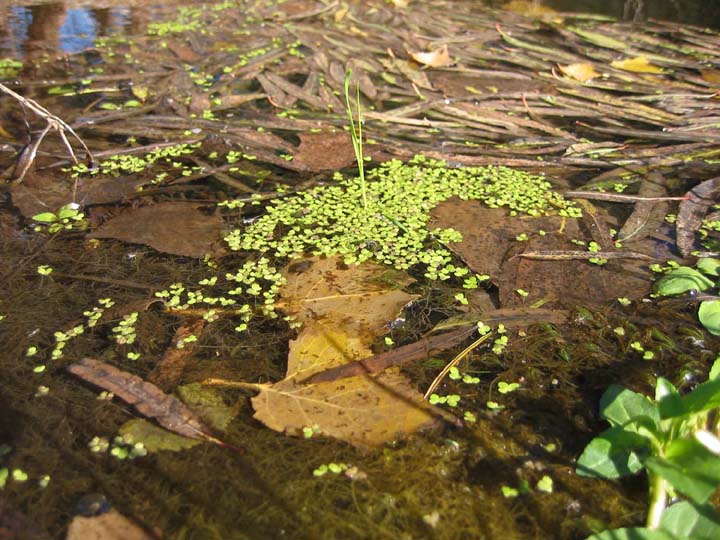Roots 1 per frond. Fronds floating or submersed, 1 or 2--20 or more, coherent in groups or forming chains, lanceolate-ovate, flat or gibbous, 1--15 mm, margins entire or denticulate, upper surfaces sometimes with small conic papillae along veins (especially at node and near apex); air spaces in tissue; reproductive pouches 2, lateral, at base from which daughter fronds and flowers originate, triangular; veins 1--5(--7), originating from point in proximal part of frond (node) or if more than 3 veins present, outer ones sometimes branching distally from inner ones; scale at base of frond absent; anthocyanins sometimes present; pigment cells absent (red pigmentation present in some species); turions absent (sometimes present in L. turionifera). Flowers 1(--2) per frond, surrounded by small utricular, membranous scale; stamens 2, 4-locular. Seeds 1--5, longitudinally ribbed. x = 10, 21, 22..
In Lemna the connection to the mother frond is formed by a thin white stipe at the base that falls off or decays after the frond is grown (frond of L. trisulca is narrowed at base into a green stalk persisting on frond).
FRONDS: floating on or below the surface of the water, lanceolate to ovate, with entire or denticulate margins, flat or gibbous, with air spaces in tissue, with two triangular lateral reproductive pouches at the base from which daughter fronds and flowers originate, without a scale at the base; nerves 1 5( 7); root 1; anthocyanins sometimes present; pigment cells absent.
FLOWERS: 1( 2) per frond, surrounded by a scale; stamens 2, 4 locular.
SEEDS: 1 5, longitudinally ribbed.
NOTES: l3 spp.; worldwide (except arctic and antarctic zones). (Greek name of a water plant).
REFERENCES: Landolt, Elias. 1992. Lemnaceae. Ariz.-Nev. Acad. Sci. 26(1)2.
Duration: Perennial
Nativity: Native
Lifeform: Forb/Herb
General: Floating or submerged aquatic herbs consisting of flattened leaf-like stems called fronds; each frond has a single root attached; fronds lanceolate-ovate, 1-15 mm long, solitary or forming groups or chains of 2-20 or more fronds; each frond has 2 triangular lateral pouches at the base, from which flowers and daughter fronds originate.
Flowers: Tiny, inconspicuous, often difficult to see without magnification, and in many species, rare; usually 1 flower per frond, emerging from a reproductive pouch at the base of the frond and surrounded by a small, bladderlike, membraneous scale; flowers lack petals and sepals; stamens 2 per flower; ovary bottle-shaped, tapering to a short style and topped with a funnel-shaped stigma.
Fruits: Follicles bursting open along a single suture line to release 1-5 seeds, these longitudinally ribbed and almost as long as the follicle.
Ecology: Found floating on or submerged beneath the surface of water.
Distribution: Lemna spp. are found worldwide except for the Arctic and Antarctic.
Notes: This is the duckweed you see floating in ponds, potholes, and slow-moving sections of streams. The small round leaf-like structures, called fronds, each have a single short root attached. You'll rarely see flowers or fruits. Lemna more often produces new plants asexually, at the ends of thin white stipes (stalks) which fall off or decay after the daughter frond is grown. Lemna and a few other genera of duckweeds were traditionally assigned to their own family, Lemnaceae. However, molecular evidence shows that Lemnaceae is nested within Araceae, a family of generally quite showy, mostly tropical plants.
Ethnobotany: According to Flora of North America, some duckweeds have a very high percentage of amino acids, up to 45% of dry weight; they are used in many regions as food for livestock; Lemna gibba is cultivated in Israel for use as a salad vegetable. Lemnaceae are also used for waste-water purification and as test and indicator plants.
Etymology: Lemna comes from the Greek word limne, marsh or pond, alluding to the plants' habitat.
Editor: AHazelton 2017
Thallus flat to strongly convex beneath, variously rotund, ovate, obovate, oblong, or stipitate, with 1-5 obscure nerves from a nodal point near the base, or nerveless; root 1, opposite the nodal point, without vascular tissue, surrounded by an inconspicuous short sheath at base; reproduction as in Spirodela; ovules 1-6; seed longitudinally ribbed and transversely striate, or smooth. 10, cosmop.
Gleason, Henry A. & Cronquist, Arthur J. 1991. Manual of vascular plants of northeastern United States and adjacent Canada. lxxv + 910 pp.
©The New York Botanical Garden. All rights reserved. Used by permission.












